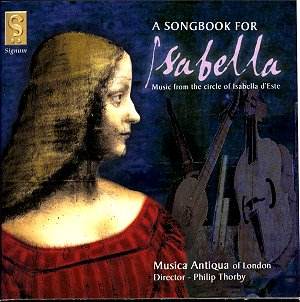This
CD gives us an opportunity to hear the music contained in a late-Renaissance
songbook belonging to a very important member of the Italian aristocracy.
The selection reflects their sophisticated tastes, their religious
expectations and their tastes in entertainment. Not surprisingly
it contains music by that most international and cosmopolitan
of Renaissance composers, Heinrich Isaac (c.1450-1515). He is
represented here by five pieces. Busnois and Josquin get only
one each. These composers are from the so-called ‘Netherlandish
school’ of the late 15th Century as are Agricola and
Ockeghem.
The
Italian ‘frottola’ is represented by several anonymous pieces
like the opening ‘Or an corere’ or by that most tuneful of Italians,
Tromboncino, as in ‘Or che di preggion’. Neither is the selection
short of sacred works with, for example, the ‘Ave Maris Stella’
which has the even verses set polyphonically and the odd ones
in ‘alternatum’- i.e. in plainsong.
With
only one singer, the normally rather blanched and pure Clare Wilkinson,
the sacred music accompanied by viols, whilst not inauthentic
or dull, is interpreted and has the same texture as the frottola.
This gives the disc a somewhat monochrome atmosphere. However
there is a touch of 1960s ‘Musica Reservata’ about some tracks
which is most welcome and adds a splash of colour. I thought that
the days of four raucous crumhorns were practically over. Well
not so, as we can hear in ‘O triumphale diamante’, a piece addressed
to a diamond admired even by the pope. The style of the song also
brings out a touch of the great Janatina Noorman in Wilkinson
… but why this song?
In
fact the group has taken a similar approach before. Listen to
the CD ‘Master of Musicians’ (Signum CD025) with Josquin’s ‘Bergerette
savoysienne’ when Jeannie Cassidy was then the strident mezzo.
Talking of which, both CDs follow a now familiar pattern of grouping
pieces under related headings. This new CD has headings such as
‘La Fortuna’ (secular love lyrics) or ‘In Festo Natalis Domini’
(Christmas pieces).
Incidentally
Isabella d’Este was a fine musician. Philip Thorby tells us in
the accompanying essay that musically Isabella "was genuinely
gifted". "She succumbed to the new craze which had swept
through the Ferraran court – the playing of consorts of the new
‘viole’ in, as her brother Alfonso was to write ‘of all the sizes
of the world’".
The
disc achieves an equal balance of vocal as against instrumental
items. The most common instruments are the set of viols. These
were made specially for Philip Thorby and the group. They are
illustrated on pages 34 and 35 of the excellent booklet. We are
told that this is "the first group in the world to commission
and use late 15th Century viols and is the only group
in Great Britain to play on matched sets of viols, crumhorns and
recorders especially commissioned for the group, mostly copied
form 16th Century originals". What difference
does it make? To the performers, a great deal. This can be communicated
to listeners in a sensitivity of performance and respect for instrumental
textures not normally encountered. This is particularly evident
with a piece realized for broken consort. The viols sound whiter
and plainer than in other versions - perhaps more restrained.
This suits this particular repertoire well and can be most beautiful
as, for example, in Isaac’s ‘Absque verba’.
It’s
good to see the Early Music Centre at the once forgotten church
of St.Margaret’s, Walmgate, in York being used for recordings.
The acoustic is excellent and there is no extraneous noise.
This
is not a high profile early music CD such as we have seen recently
from ‘The Harp Consort’ or in the past from Gothic Voices. It
contains repertoire raked over before, but it is a very civilized
disc with music to charm and excite. The performers are clear
about their objectives and they know musically how to achieve
them.
Gary
Higginson

